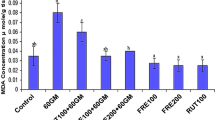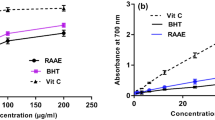Abstract
Gentamicin (GM) is an aminoglycoside antibiotic used to treat bacterial infections. Nephrotoxicity refers to the impairments of the kidneys caused by the use of GM and can result in decreased kidney function and in severe cases, kidney failure. Aronia melanocarpa extract (AME), also known as the black chokeberry, has been used for its protective effects on the kidneys. AME concentration of 3.38 mg/kg (max antioxidant activity in vitro) was used to determine its effectiveness against induced nephropathy during 30 days. GM treatment caused significant hypoalbuminemia and high values of globulins, creatinine, and urea compared to the control group. GM application lead to hemolysis occurrence, echinocytosis, and platelets aggregation. Significantly high values of segmented neutrophils and low values of non-segmented neutrophils were recorded in the blood of rats treated with chokeberry extract (AME). In the pre-treatment (AME + GM), severe hypochromic anemia and a significant improvement in hematological parameters, as well as a reduction of anemia in the post-treatment (GM + AME), were noted. Post-treatment AME also significantly regulates urea and creatinine values. Statistically significantly low hemoglobin values were found in all groups treated with AME. Current study suggests that compounds in the AME have a moderate beneficial effect against renal injury and anti-inflammatory properties that may help protect the kidneys from injury caused by GM.





Similar content being viewed by others
Data Availability
The data that support the findings of this study are available from the corresponding author upon request.
References
Cuzzocrea, S., Mazzon, E., Dugo, L., Serraino, I., Di Paola, R., Britti, D., De Sarro, A., Pierpaoli, S., Caputi, A., Masini, E., & Salvemini, D. (2002). Effect of N-acetylcysteine on gentamicin-mediated nephropathy in rats. European Journal of Pharmacology, 450, 67–76. https://doi.org/10.1016/s0014-2999(01)01130-x
Rodrigues, F. A., Prata, M. M., Oliveira, I. C., Alves, N. T., Freitas, R. E., & Monteiro, H. S. (2014). Gingerol fraction from Zingiber officinale protects against gentamicin-induced nephrotoxicity. Antimicrobial Agents and Chemotherapy, 58(4), 1872–1878. https://doi.org/10.1128/AAC.02431-13
Moreira, M. A., Nascimento, M. A., Bozzo, T. A., Cintra, A., da Silva, S. M., & Dalboni, M. A. (2014). Ascorbic acid reduces gentamicin-induced nephrotoxicity in rats through the control of reactive oxygen species. Clinical Nutrition, 33(2), 296–301. https://doi.org/10.1016/j.clnu.2013.05.005
El-Kashef, D. H., El-Kenawi, A. E., Rahim, M. A., Suddek, G. M., & Salem, H. A. (2016). Agmatine improves renal function in gentamicin-induced nephrotoxicity in rats. Canadian Journal of Physiology and Pharmacology, 94(3), 278–286. https://doi.org/10.1139/cjpp-2015-0321
Christo, J. S., Rodrigues, A. M., Mouro, M. G., Cenedeze, M. A., de Jesus Simões, M., Schor, N., et al. (2011). Nitric oxide (NO) is associated with gentamicin (GENTA) nephrotoxicity and the renal function recovery after suspension of GENTA treatment in rats. Nitric Oxide, 24, 77–83. https://doi.org/10.1016/j.niox.2010.12.001
El, M. M., Laurent, G., Mingeot-Leclercq, M. P., et al. (2000). Gentamicin-induced apoptosis in renal cell lines and embryonic rat fibroblasts. Toxicological Sciences, 56, 229–239. https://doi.org/10.1093/toxsci/56.1.229
Dam, V. P., Scott, J. L., & Ross, A. (2012). Inhibition of cystathionine gamma-lyase and the biosynthesis of endogenous hydrogen sulphide ameliorates gentamicin-induced nephrotoxicity. European Journal of Pharmacology, 685, 165–173. https://doi.org/10.1016/j.ejphar.2012.04.030
Sandhu, J. S., Sehgal, A., Gupta, O. A., & Singh, A. (2007). Aminoglycoside nephrotoxicity revisited. Journal Indian Academy of Clinical Medicine, 8(4), 331–333.
Slimestad, R., Torskangerpoll, K., Nateland, H. S., Johannessen, T., & Giske, N. H. (2005). Flavonoids from black chokeberries, Aronia melanocarpa. Journal of Food Composition and Analysis, 18, 61–68. https://doi.org/10.1016/j.jfca.2003.12.003
Bushmeleva, K., Vyshtakalyuk, A., Terenzhev, D., Belov, T., Parfenov, A., Sharonova, N., Nikitin, E., & Zobov, V. (2021). Radical scavenging actions and immunomodulatory activity of Aronia melanocarpa propylene glycol extracts. Plants (Basel), 10(11), 2458. https://doi.org/10.3390/plants10112458
Christiansen, C. B., Mellbye, F. B., Hermansen, K., Jeppesen, P. B., & Gregersen, S. (2022). Effects of Aronia melanocarpa on cardiometabolic diseases: A systematic review of quasi-design studies and randomized controlled trials. The Review of Diabetic Studies, 18, 76–92. https://doi.org/10.1900/RDS.2022.18.76
Seeram, N. P., & Nair, M. G. (2002). Inhibition of lipid peroxidation and structure-activity-related studies of the dietary constituents anthocyanins, anthocyanidins, and catechins. Journal of Agriculture and Food Chemistry, 50(19), 5308–5312. https://doi.org/10.1021/jf025671q
Skarpańska-Stejnborn, A., Basta, P., Sadowska, J., & Pilaczyńska-Szcześniak, L. (2014). Effect of supplementation with chokeberry juice on the inflammatory status and markers of iron metabolism in rowers. Journal of the International Society of Sports Nutrition, 11(1), 48. https://doi.org/10.1186/s12970-014-0048-5
Silan, C., Uzun, O., Comunoğlu, N. U., Gokçen, S., Bedirhan, S., & Cengiz, M. (2007). Gentamicin-induced nephrotoxicity in rats ameliorated and healing effects of resveratrol. Biological &/and Pharmaceutical Bulletin, 30(1), 79–83. https://doi.org/10.1248/bpb.30.79
Suljević, D., Mitrašinović-Brulić, M., & Fočak, M. (2022). L-cysteine protective effects against platelet disaggregation and echinocyte occurrence in gentamicin-induced kidney injury. Molecular and Cellular Biochemistry, 478, 13–22. https://doi.org/10.1007/s11010-022-04498
Ramić, M., Vidović, S., Zeković, Z., Vladić, J., Cvejin, A., & Pavlić, B. (2015). Modeling and optimization of ultrasound-assisted extraction of polyphenolic compounds from Aronia melanocarpa by-products from filter-tea factory. Ultrasonics Sonochemistry, 23, 360–368. https://doi.org/10.1016/j.ultsonch.2014.10.002
Nurcholis, W., Alfadzrin, R., Izzati, N., Arianti, R., Vinnai, B. Á., Sabri, F., Kristóf, E., & Artika, I. M. (2022). Effects of methods and durations of extraction on total flavonoid and phenolic contents and antioxidant activity of java cardamom (Amomum compactum soland ex maton) fruit. Plants, 11, 2221. https://doi.org/10.3390/plants11172221
Jakobek, L., Šeruga, M., Medvidović-Kosanović, M., & Novak, I. (2007). Antioxidant activity and polyphenols of Aronia in comparison to other berry species. Agriculturae Conspectus Scientificus, 72, 301–306.
Jing, P., Bomser, J. A., Schwartz, S. J., He, J., Magnuson, B. A., & Giusti, M. M. (2008). Structure-function relationships of anthocyanins from various anthocyanin-rich extracts on the inhibition of colon cancer cell growth. Journal of Agriculture and Food Chemistry, 56, 9391–9398. https://doi.org/10.1021/jf8005917
Ho, G. T., Bräunlich, M., Austarheim, I., Wangensteen, H., Malterud, K. E., Slimestad, R., & Barsett, H. (2014). Immunomodulating activity of Aronia melanocarpa polyphenols. International Journal of Molecular Sciences, 15, 11626–11636. https://doi.org/10.3390/ijms150711626
Xu, J., & Mojsoska, B. (2013). The immunomodulation effect of Aronia extract lacks association with its antioxidant anthocyanins. Journal of Medicinal Food, 16, 334–342. https://doi.org/10.1089/jmf.2012.0151
Ahn, J. M., You, S. J., Lee, Y. M., Oh, S. W., Ahn, S. Y., Kim, S., Chin, H. J., Chae, D. W., & Na, K. Y. (2012). Hypoxia-inducible factor activation protects the kidney from gentamicin-induced acute injury. PLoS ONE, 7, e48952. https://doi.org/10.1371/journal.pone.0048952
Karahan, I., Ateşşahin, A., Yilmaz, S., Çeribaşi, A. O., & Sakin, F. (2005). Protective effect of lycopene on gentamicin-induced oxidative stress and nephrotoxicity in rats. Toxicology, 215, 198–204. https://doi.org/10.1016/j.tox.2005.07.007
Banday, A. A., Farooq, N., Priyamvada, S., Yusufi, A., & Khan, F. (2008). Time dependent effects of gentamicin on the enzymes of carbohydrate metabolism, brush border membrane and oxidative stress in rat kidney tissues. Life Sciences, 82(9), 450–459. https://doi.org/10.1016/j.lfs.2007.11.014
Khan, S. A., Priyamvada, S., Farooq, N., Khan, S., Khan, M. W., & Yusufi, A. N. K. (2009). Protective effect of green tea extract on gentamicin-induced nephrotoxicity and oxidative damage in rat kidney. Pharmacological Research, 59, 254–262. https://doi.org/10.1016/j.phrs.2008.12.009
Kalayarasan, S., Prabhu, P. N., Sriram, N., Manikandan, R., Arumugam, M., & Sudhandiran, G. (2009). Diallyl sulfide enhances antioxidants and inhibits inflammation through the activation of Nrf2 against gentamicin-induced nephrotoxicity in Wistar rats. European Journal of Pharmacology, 606, 162–171. https://doi.org/10.1016/j.ejphar.2008.12.055
Edwards, J. R., Diamantakos, E. A., Peuler, J. D., Lamar, P. C., & Prozialeck, W. C. (2007). A novel method for the evaluation of proximal tubule epithelial cellular necrosis in the intact rat kidney using ethidium homodimer. BMC Physiology, 7, 1. https://doi.org/10.1186/1472-6793-7-1
Li, J., Li, Q. X., Xie, X. F., Ao, Y., Tie, C. R., & Song, R. J. (2009). Differential roles of dihydropyridine calcium antagonist nifedipine, nitrendipine and amlodipine on gentamicin-induced renal tubular toxicity in rats. European Journal of Pharmacology, 620(1–3), 97–104. https://doi.org/10.1016/j.ejphar.2009.08.021
Dhanarasu, S., Selvam, M.S., Alkhalaf, A.A., Aloraifi, A.K.K., Al-Shammari, N.K.A. (2018) Ameliorative and erythrocytes membrane stabilizing effects of Mentha piperita on experimentally induced nephrotoxicity by gentamicin. Egyptian Academic Journal of Biological Sciences 3(10), 23–37. https://doi.org/10.21608/eajbsc.2018.13653.
Milutinovic, M., Velickovic Radovanovic, R., Savikin, K., Radenkovic, S., Arvandi, M., Pesic, M., Kostic, M., Miladinovic, B., Brankovic, S., Kitic, D. (2019) Chokeberry juice supplementation in type 2 diabetic patients - impact on health status. Journal of Applied Biomedicine 17(4), 218–224. https://doi.org/10.32725/jab.2019.020.
Handeland, M., Grude, N., Torp, T., & Slimestad, R. (2014). Black chokeberry juice (Aronia melanocarpa) reduces incidences of urinary tract infection among nursing home residents in the long term-a pilot study. Nutrition Research, 34, 518–525. https://doi.org/10.1016/j.nutres.2014.05.005
Li, L., Li, J., Xu, H., Zhu, F., Li, Z., Lu, H., Zhang, J., Yang, Z., Liu, Y. (2021) The Protective Effect of anthocyanins extracted from Aronia melanocarpa berry in renal ischemia-reperfusion injury in mice. Mediators of Inflammation, e7372893. https://doi.org/10.1155/2021/7372893
Denev, P., Kratchanov, C., Číž, M., Lojek, A., & Kratchanova, M. (2012). Bioavailability and antioxidant activity of black chokeberry (Aronia melanocarpa) polyphenols: In vitro and in vivo evidences and possible mechanisms of action: A review. Comprehensive Reviews in Food Science and Food Safety, 11(5), 471–489.
Kasprzak-Drozd, K., Oniszczuk, T., Soja, J., Gancarz, M., Wojtunik-Kulesza, K., Markut-Miotła, E., & Oniszczuk, A. (2021). The efficacy of black chokeberry fruits against cardiovascular diseases. International Journal of Molecular Sciences, 22(12), 6541. https://doi.org/10.3390/ijms22126541
Sakurai, S., Shiojima, I., Tanigawa, T., & Nakahara, K. (1997). Aminoglycosides prevent and dissociate the aggregation of platelets in patients with EDTA-dependent pseudothrombocytopenia. British Journal of Haematology, 99(4), 817–823. https://doi.org/10.1046/j.1365-2141.1997.4773280.x
Chen, G., Fei, X., & Ling, J. (2012). The effects of aminoglycoside antibiotics on platelet aggregation and blood coagulation. Catheterization and Cardiovascular Interventions, 18(5), 538–541. https://doi.org/10.1177/1076029611430955
Luzak, B., Golanski, J., Rozalski, M., Krajewska, U., Olas, B., & Watala, C. (2010). Extract from Aronia melanocarpa fruits potentiates the inhibition of platelet aggregation in the presence of endothelial cells. Archives of Medical Science, 6, 141–144. https://doi.org/10.5114/aoms.2010.13884
Olas, B., Wachowicz, B., Tomczak, A., Erler, J., Stochmal, A., & Oleszek, W. (2008). Comparative anti-platelet and antioxidant properties of polyphenol-rich extracts from: Berries of Aronia melanocarpa, seeds of grape and bark of Yucca schidigera in vitro. Platelets, 19, 70–77. https://doi.org/10.1080/09537100701708506
Sikora, J., Broncel, M., Markowicz, M., Chałubiński, M., Wojdan, K., & Mikiciuk-Olasik, E. (2012). Short-term supplementation with Aronia melanocarpa extract improves platelet aggregation, clotting, and fibrinolysis in patients with metabolic syndrome. European Journal of Nutrition, 51(5), 549–556. https://doi.org/10.1007/s00394-011-0238-8
Hider, R., Liu, Z., & Khodr, H. (2001). Metal chelation of polyphenols. Methods in Enzymology, 335, 190–203. https://doi.org/10.1016/s0076-6879(01)35243-6
Alsagaby, S. A. (2022). A comprehensive study on abnormalities associated with red blood cells in Saudi adult patients. International Journal of Health Sciences, 16(1), 30–36.
Author information
Authors and Affiliations
Contributions
All authors contributed to the study conception and design. Material preparation, data collection, and analysis were performed by Muhamed Fočak, Maja Mitrašinović-Brulić, and Damir Suljević. The first draft of the manuscript was written by Muhamed Fočak and all authors commented on previous versions of the manuscript. All authors read and approved the final manuscript.
Corresponding author
Ethics declarations
Ethics Approval
The Law on the Protection and Welfare of Animals applies to experiments with animals (Official Gazette of BiH, No. 25/2009 and 9/2018) in Bosnia and Herzegovina.
Competing Interests
The authors declare no competing interests.
Additional information
Publisher's Note
Springer Nature remains neutral with regard to jurisdictional claims in published maps and institutional affiliations.
Rights and permissions
Springer Nature or its licensor (e.g. a society or other partner) holds exclusive rights to this article under a publishing agreement with the author(s) or other rightsholder(s); author self-archiving of the accepted manuscript version of this article is solely governed by the terms of such publishing agreement and applicable law.
About this article
Cite this article
Fočak, M., Mitrašinović-Brulić, M. & Suljević, D. Aronia melanocarpa (Michx.) Elliott 1821 Extract Has Moderate Ameliorative Influence on Biochemical and Hematological Parameters in Gentamicin-Induced Nephropathy in Wistar Rats. Appl Biochem Biotechnol 196, 896–908 (2024). https://doi.org/10.1007/s12010-023-04573-z
Accepted:
Published:
Issue Date:
DOI: https://doi.org/10.1007/s12010-023-04573-z




